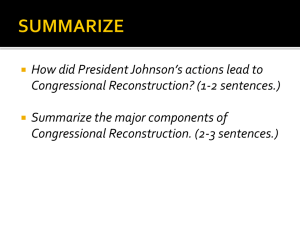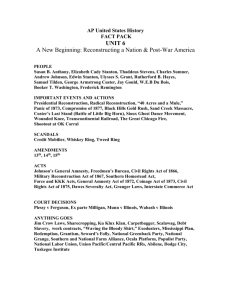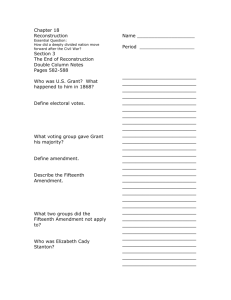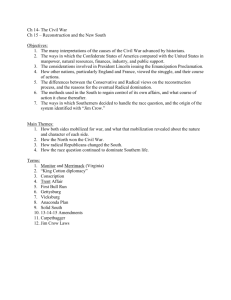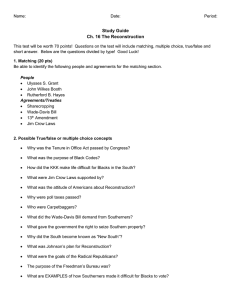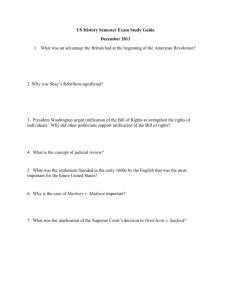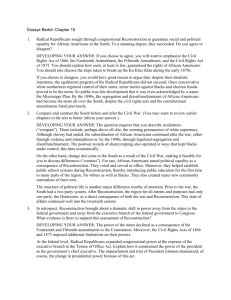U.S. History Mr. Detjen Reading Study Guide “Reconstruction, 1865
advertisement
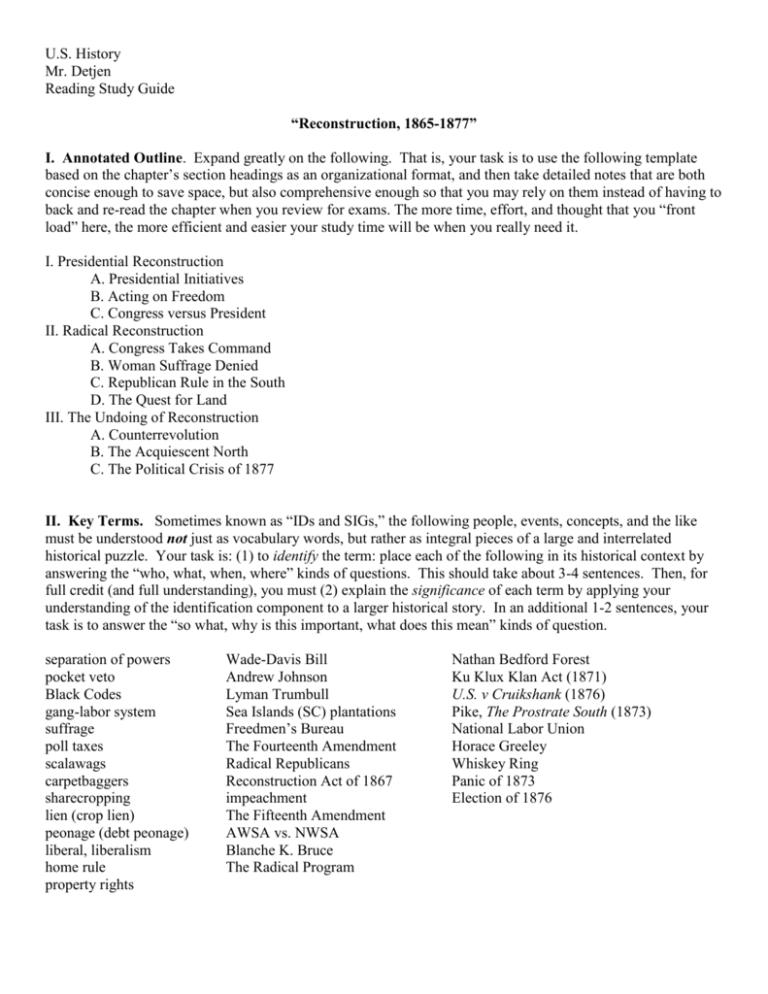
U.S. History Mr. Detjen Reading Study Guide “Reconstruction, 1865-1877” I. Annotated Outline. Expand greatly on the following. That is, your task is to use the following template based on the chapter’s section headings as an organizational format, and then take detailed notes that are both concise enough to save space, but also comprehensive enough so that you may rely on them instead of having to back and re-read the chapter when you review for exams. The more time, effort, and thought that you “front load” here, the more efficient and easier your study time will be when you really need it. I. Presidential Reconstruction A. Presidential Initiatives B. Acting on Freedom C. Congress versus President II. Radical Reconstruction A. Congress Takes Command B. Woman Suffrage Denied C. Republican Rule in the South D. The Quest for Land III. The Undoing of Reconstruction A. Counterrevolution B. The Acquiescent North C. The Political Crisis of 1877 II. Key Terms. Sometimes known as “IDs and SIGs,” the following people, events, concepts, and the like must be understood not just as vocabulary words, but rather as integral pieces of a large and interrelated historical puzzle. Your task is: (1) to identify the term: place each of the following in its historical context by answering the “who, what, when, where” kinds of questions. This should take about 3-4 sentences. Then, for full credit (and full understanding), you must (2) explain the significance of each term by applying your understanding of the identification component to a larger historical story. In an additional 1-2 sentences, your task is to answer the “so what, why is this important, what does this mean” kinds of question. separation of powers pocket veto Black Codes gang-labor system suffrage poll taxes scalawags carpetbaggers sharecropping lien (crop lien) peonage (debt peonage) liberal, liberalism home rule property rights Wade-Davis Bill Andrew Johnson Lyman Trumbull Sea Islands (SC) plantations Freedmen’s Bureau The Fourteenth Amendment Radical Republicans Reconstruction Act of 1867 impeachment The Fifteenth Amendment AWSA vs. NWSA Blanche K. Bruce The Radical Program Nathan Bedford Forest Ku Klux Klan Act (1871) U.S. v Cruikshank (1876) Pike, The Prostrate South (1873) National Labor Union Horace Greeley Whiskey Ring Panic of 1873 Election of 1876 III. Chapter Review Analysis. The minimum expectation here is 2-4 paragraphs, each of 8-10 sentences. This is the culminating task of reading, comprehending, and thinking critically about the chapter under consideration. You have taken notes on/outlined the chapter, you have analyzed and applied some specific terminology (a “bottom-up” cognitive process), and now, finally, you are asked to tell a few broad, sweeping stories (a “top down” cognitive process) all the while making sure to incorporate the “evidence” of the key terms and related knowledge you may have that pertains to the question. Your answers should demonstrate your understanding of the “big picture” as well as the specific details which constitute the supporting evidence that reinforces your interpretation. I’m not in search of the “right answer” here, rather a well-supported position, an interpretation backed up by evidence. (Hint: make very good use of appropriate, related IDs and SIGs to support the position you take on the question at hand.) 1. Why and how did the debate over restoring the South to the Union devolve into an institutional struggle between the presidency and the Congress? 2. Do you believe that the failure of Reconstruction was primarily a failure of leadership? Or, to put it more concretely, how might the outcome have been different had Lincoln lived? Or chosen a different vice president? 3. Was there any way of reconciling the Republican desire for equality for the ex-slaves with the exConfederate desire for self-rule in the South?
